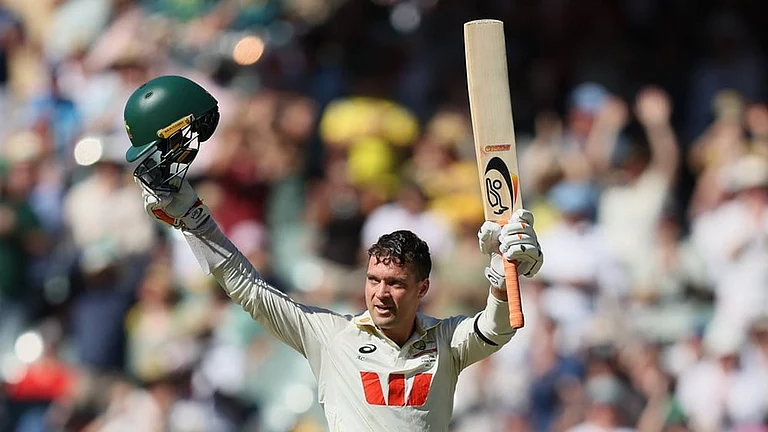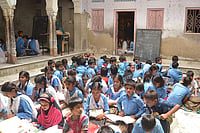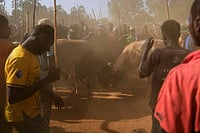Till three or four years ago, large ferocious-looking vultures were to be seen on top of most of the large Mughal tombs that are scattered around Delhi, perched as if they were carved in stone. Elsewhere, these greyish-brown birds would be in trees, searching through the smog for carcasses to ravage. Now they're not to be seen.
It would be tempting to assume that even these scavengers have been driven out of the world's fourth most polluted city. But these birds have left not just Delhi: they're declining in most parts of India. Reports from as far afield as Himachal Pradesh and Tamil Nadu tell of vultures disappearing, while dead and dying birds were even found last week on the manicured lawns of Calcutta's Tollygunge Club.
No one is sure how many there used to be, nor the rate of decline - and the reasons for their disappearance is a mystery that's baffling experts. What's sure is that their absence poses serious health hazards for a country with chronically low levels of public hygiene and healthcare.
Some experts believe vultures could be facing extinction and describe this as a "possible Pandora's box" of what is happening to the environment. "Vultures are important ecologically," says Asad Rahmani, director of the Bombay Natural History Society and one of India's top ornithologists. "They remove the carcasses of dead animals which, otherwise, are left lying around rotting - thus increasing the risk of spreading disease."
Vultures are birds of prey, though the species that occur in India are mostly carrion-eaters. They have wing-spans of up to two metres and a keen eyesight and sense of smell that enable them to spot food. The speed and efficiency with which they remove carcasses is staggering. An army of 200 vultures can reduce a large buffalo carcass to a skeleton in 20 minutes.
Statistics are scarce - vultures aren't popular with researchers or wildlife conservationists, who focus on more glamorous and fashionable endangered species like tigers and elephants. The most stark figures are from Bharatpur's bird sanctuary. The number of vultures there has plummeted from about 2,000 in '86 to just eight so far this year.
Villagers were the first to spot it in the mid '90s. There are now reports of the decline - and of rotting carcasses - from all over India. Rahmani says he recently saw nine uneaten carcasses on the 250-km road between Jaipur and Delhi.
Messages on the Net show it's a global problem. Experts have filed reports from as far afield as Israel's Golan Heights, South Africa, Latin America and the US. Sanctuary, a British defence ministry magazine, ran an article last year from Cyprus that said griffon vultures had declined from "hundreds" 50 years ago to about 100 in the '80s and just 24 last year. But experts abroad seem to have no better idea about the exact source of the problem than those in India. "It could be pesticides or general pollution or some poisoning or disease or a combination of them all," says Rahmani. "My hunch is pesticides, but we have not yet got a detailed study to provide us with concrete evidence. "
Pesticides could be working through the bodies of dead cows, buffaloes and other carcasses eaten by vultures. As a result, vultures' eggs would have thin shells that break during incubation before the chicks can form and hatch. Significantly, no vulture chicks have hatched at Bharatpur for the past two years. Adult birds too are falling sick, presumably diseased or poisoned.
Pesticides have been blamed globally for killing birds for 30 years or more. The Smithsonian Migratory Bird Centre of the US says "population decline and extensive mortality of birds strongly indicate that the health of the environment, and thus the health of organisms that depend on it, suffers due to the prevalence of pesticides".
A sample survey of eight cattle and pig carcasses collected last December in Delhi, Bharatpur and other north Indian locations by the Delhi-based Centre for Science and Environment found high levels of pesticides, including ddt that's still widely used, though its use in agriculture is banned.
Pesticides are a sensitive issue - especially after the damage they caused to cotton-growers. So it's not surprising, given the reach of the pesticides commercial lobby, that some experts steer clear from blaming pesticides and emphasise other possible reasons for the birds' disappearance. They cite: lack of food (more efficient carcass disposal in cities), vultures being killed and indirect poisoning through baits laid for predators. Also, quacks pay Rs 3,000 for remains of dead vultures they use in their remedies.
But most experts dismiss these causes as marginal. Vibhu Prakash, the leading field researcher on the subject, suspects that pesticides or an unknown disease are the likely causes. But he has reservations. He says pesticides do not usually accumulate enough in mammals (which vultures eat) to do the damage - unless the pesticide dose is extremely heavy. On the other hand, vultures have not been hit by an outbreak of disease elsewhere in the world.
So, the case of the disappearing vultures is far from being solved. It looks like a global issue but is especially serious in India. Primarily because populations of street dogs will mushroom if their food supplies increase significantly.
One biologist, S.M. Satheesan, suggests (seriously, believe it or not) that the answer is to set up vulture "restaurants" in or near nature reserves where vultures can be fed till their numbers increase again! But, clearly, a more fundamental solution is needed.
It may seem laughable to suggest that vultures are desirable birds to be labelled as an endangered species deserving preservation. But it's better to have them perched menacingly atop Delhi's Mughal tombs while they wait for their next meal than to have carcasses rotting by the roadside.


























